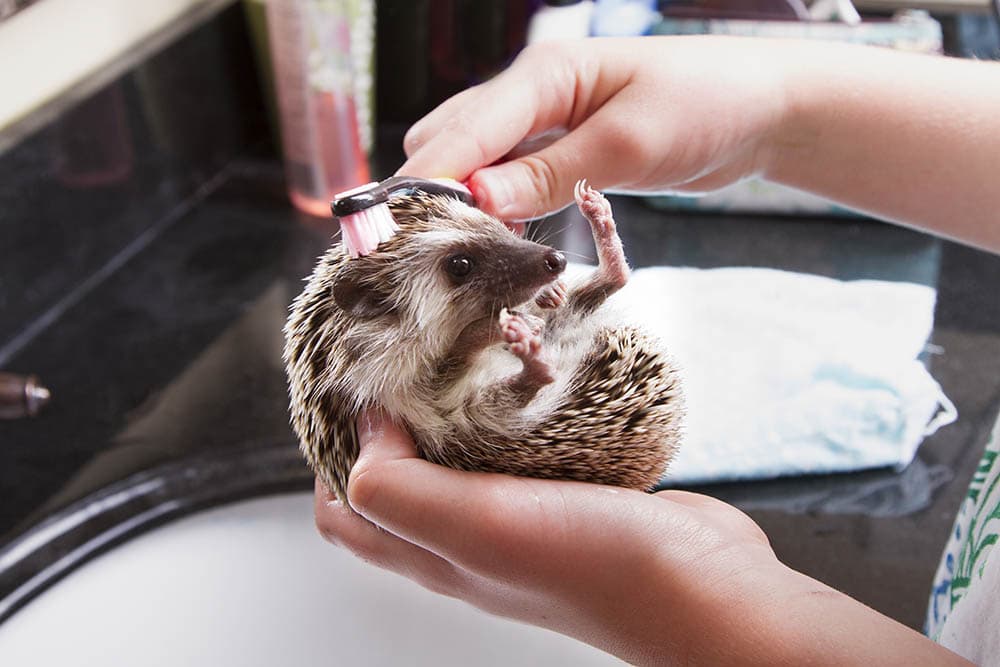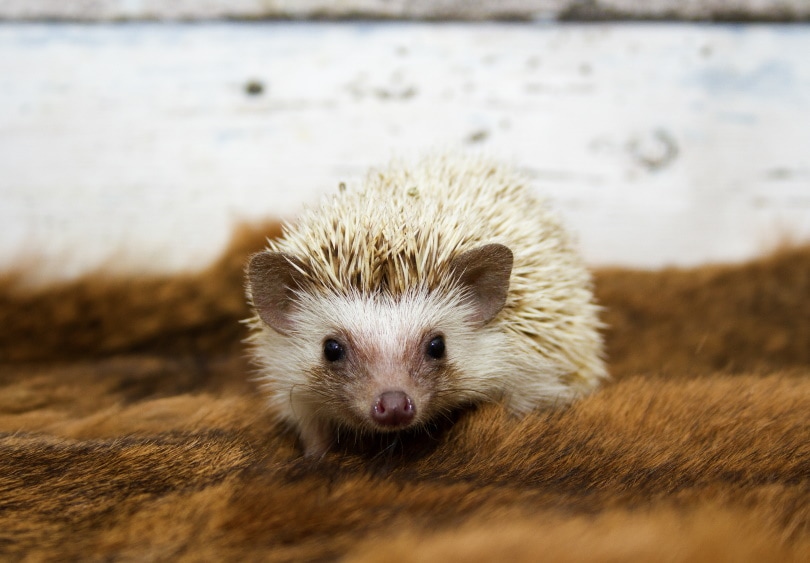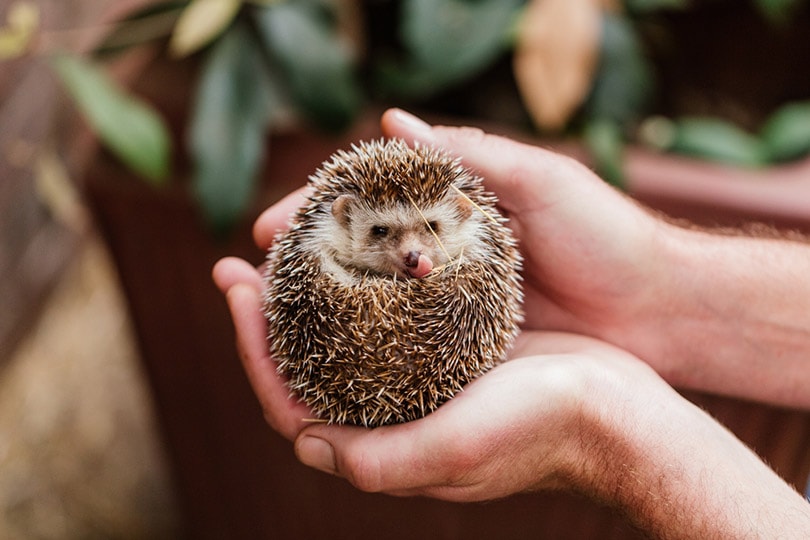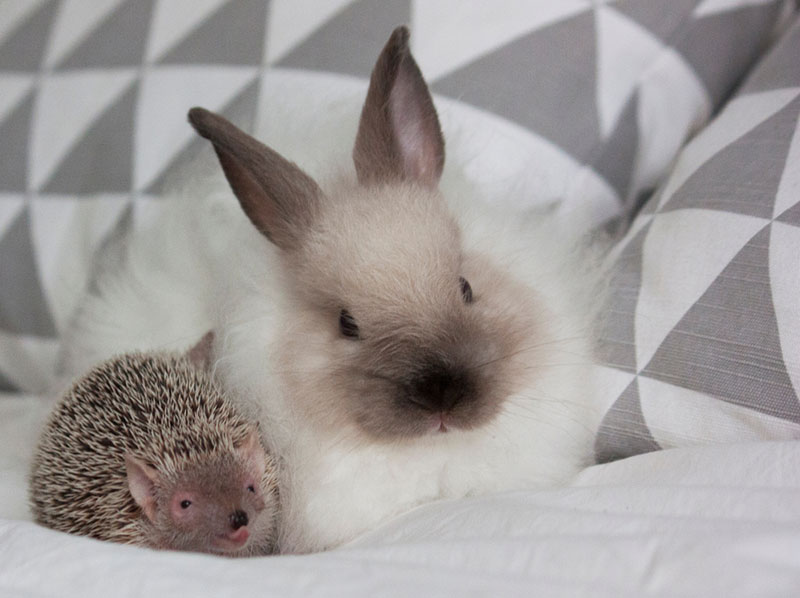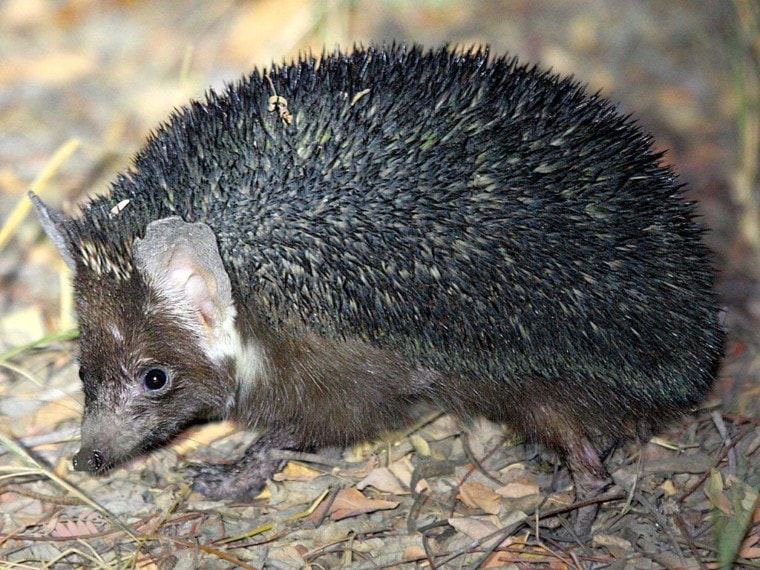
Click to Skip Ahead
Fast, bristly, and small, Brandt’s hedgehog is a unique species of hedgehog that are rarely kept in captivity. They have many interesting characteristics that make them a rewarding exotic pet to own.
There is not much known about their care in captivity, so we have created this guide for you to help you understand this species of hedgehog’s care requirements, what traits you can expect to see in this species, and how you can provide this hedgehog with the best possible care in captivity.
Quick Facts about Brandt’s Hedgehog Info
| Species Name: | Paraechinus hypomelas |
| Family: | Erinaceidae |
| Care Level: | Easy |
| Temperature: | 75-85 degrees Fahrenheit |
| Temperament: | Friendly, docile |
| Color Form: | Dark brown |
| Lifespan: | 4 to 6 years |
| Size: | 9-12 inches |
| Diet: | Insectivore |
| Minimum Enclosure Size: | 3 by 2 feet |
| Enclosure Set-Up: | Wheel, bedding, ventilation, water, food |
| Compatibility: | Poor, single housing |
Brandt’s Hedgehog Overview
The Brandt’s hedgehog is a small middle eastern hedgehog with distinctively large ears. They are fast, adaptive, and have much lighter needles than other hedgehogs. This is a desert-dwelling species, and it can be found throughout Middle Asia and the Middle East. Here they inhabit desert zones and arid steppes from Iran, Turkmenistan, and eastwards to the region of Uzbekistan down to Northern Pakistan.
This hedgehog is a mammal in the family Erinaceidae and can be found in the Afrotropic, the Palearctic, and the Indomalaya realm. They’re nocturnal and mainly feed off insects that form the primary portion of their diet.
They live in burrows that they either construct themselves or find abandoned by other animals. A distinguishable characteristic of this hedgehog that makes them stand out is their long ears accompanied by a small body.
You can expect a Brandt’s hedgehog to live anywhere between 4 to 8 years of age, with 6 years being the most common lifespan of this species.
How Much Do Brandt’s Hedgehogs Cost?
Most hedgehogs will cost between $100 to $300 to buy. The price depends on where you get your hedgehog from, such as a breeder, pet store, or from a local exotic rescue center. If you do buy from a breeder, they may charge slightly extra because they will usually have a healthier selection of hedgehogs to choose from. Whereas adopting a hedgehog is significantly cheaper and the adoption fee is around $40 to $100.
Typical Behavior & Temperament
Overall, Brandt’s hedgehog is docile and friendly for the most part. The temperament and behaviors you should expect from your hedgehog depend on their personalities, but their species temperament does play a small role in their behaviors. Since hedgehogs are nocturnal, you will not get to see much of their typical behaviors during the daytime.
If you want to get to handle your hedgehog, you will have to do so in the evening when your hedgehog starts to wake up and display their usual activities. Not all Brandt hedgehogs will enjoy being handled, so you may need to tame them first to get them used to human interaction.
Appearance & Varieties
The Brandt’s hedgehog is similar in size to the West European hedgehog at around 11 to 12 inches making them quite large. They have large ears similar to the long-eared hedgehog, however, they are not the same.
This hedgehog also has lighter needle protection which makes them fast runners. Since they are so fast, they can be more difficult to handle, and you need to be cautious when handling them to ensure that they do not accidentally get dropped and injured.
The coloration of Brandt’s hedgehog ranges from a dark brown to an almost blackish-grey color. Their eyes are glossy black and may have a ruby appearance when their eyes catch the light. The spines are darker than the rest of their body and form a hard, protective dark brown cover across their back. The underside of their body is a light brown, and their snout is pointed accompanied by large pink ears and a small head.
 How to Take Care of Brandt’s Hedgehogs
How to Take Care of Brandt’s Hedgehogs
Habitat, Conditions & Setup
Enclosure Size
A big enclosure is always better when it comes to hedgehogs. The minimum sized enclosure for an adult Brandt hedgehog is 3 by 2 feet in length. This will allow you to add enough enrichment items into their enclosure without taking up too much space. Your hedgehog should still have enough room to comfortably move around the enclosure at night without feeling cramped.
You can find a suitable hedgehog enclosure both online and at pet stores. The enclosure can range from large fish tanks with a custom-made mesh lid, to wired rabbit enclosures, and even homemade wooden enclosures that can be built to a custom size and design that appeals to you.
Bedding
Your Brandt’s hedgehog will do best on a soft substrate that is comfortable for them to walk on and nest in. Wood-based substrates are a good option, this can include soft granules or aspen wood shavings. You can also use pellets and coconut husk mixed with dried grasses sold for rabbits and guinea pigs.
Temperature
Hedgehogs are most comfortable at a temperature between 75 to 85 degrees Fahrenheit. Temperatures that fluctuate too often can cause your hedgehog to become lethargic and temperatures that get too cold can cause them to hibernate which can be fatal in captivity.
If you live in a climate that is cold all year round, you may want to invest in a secure heating method such as a heating lamp or pad. This can be placed on one side of the enclosure to prevent your hedgehog from overheating and allow them to choose a temperature gradient that they feel comfortable at. Most hedgehog owners will place the heating lamp on a low setting near the nest.
Enrichment
Supplementing your hedgehog with different toys can help prevent boredom and provide them with mental stimulation. Toys that promote activity and encourage them to explore are a good idea and seem to be the most entertaining for them. This can include foraging toys where food can be hidden and then your hedgehog has to search for them.
Smaller toys that they can push around will also work, but not all hedgehogs engage with these toys and you will need to find toys that work best for your hedgehog.
 Do Brandt’s Hedgehogs Get Along with Other Pets?
Do Brandt’s Hedgehogs Get Along with Other Pets?
Hedgehogs do not get along well with other pets, or even other hedgehogs. It is better to house them alone and you should only try to keep multiple hedgehogs together if you are experienced in all aspects of their care.
It is possible to keep an all-female group of hedgehogs together as they are more likely to accept each other. It is not recommended to keep males together due to the competition and dominance that will occur between them.
Hedgehogs should never be housed with other types of animals such as rabbits or guinea pigs. This is mainly because the hedgehog will feel insecure and stressed. When they are uncomfortable hedgehogs will curl into a tight ball and extend their spines which can be fatal to other animals, including curious dogs and cats.
What to Feed Your Brandt’s Hedgehog
Brandt’s hedgehogs are insectivores or omnivores like most other species of hedgehogs. Your hedgehog should mainly be fed a high-quality commercial diet with supplements added in. It may be difficult to replicate their natural diet at home, but if you have access to exotic pet stores that sell feeder insects (mealworms, roaches, crickets) then you can feed these live foods alongside a commercial pellet diet.
Since hedgehogs will also eat fallen birds’ eggs, fruits, and small rodents or baby birds in the wild, you can also introduce fruit, boiled chicken eggs, and feeder pinkie mice into their diet to ensure that they are receiving a balanced and optimal diet.
Keeping Your Brandt’s Hedgehog Healthy
There are four main key elements to keeping your hedgehog healthy in captivity. This includes their enclosure, diet, enrichment, and health status.
All hedgehogs should have a large, well-ventilated enclosure with plenty of enrichment. Providing your hedgehog with a solid running wheel with a diameter larger than 12 inches can allow them to run at night to get rid of some energy.
The enclosure should be kept clean and old feces should be removed once a week to keep their environment hygienic. Bedding may need to be changed if it gets dirty quickly or smells. Wipe down surfaces with a pet-safe disinfectant once a week and change the water every three days to ensure it is always kept fresh.
Feed your hedgehog a variety of different foods to keep them healthy. If your hedgehog is lacking certain nutrients from their diet, then this will affect their overall health in the long run.
Breeding
When breeding Brandt hedgehogs, improving the species lineage should be your main motivation. Breeding these hedgehogs should only be accomplished if you are very knowledgeable on their genetics, the pros, and cons to breeding certain lineages, and most importantly you must work closely with an exotic veterinarian for guidance.
These hedgehogs reach sexual maturity at around two years old and mainly reproduce between April to September. They are easy to breed, and you need two healthy mature adults to get started.
It is important to know that stressed mothers will eat their babies, so the nursing conditions should be kept comfortable for the health and longevity of the babies. Furthermore, breeding hedgehogs who carry the wobbly hedgehog gene may produce offspring with the same condition. This condition is common and often results in the babies not living as long as they should.
 Are Brandt’s Hedgehogs Suitable for You?
Are Brandt’s Hedgehogs Suitable for You?
If you are looking for a docile, friendly, and undemanding exotic pet to care for then the Brandt’s hedgehog may be right for you. Keep in mind that they are not as easy to handle as other animals are not a cuddly type of pet and are more of a watch-only pet.
Brandt’s hedgehogs are not commonly sold as pets like other hedgehogs are so you will need to do a bit more searching for this exact species. If they are legal in your country, then you will be able to find local breeders in your area where you can acquire them from. However, if they are illegal or protected in your country then a permit is required.
Overall, owning a Brandt hedgehog is rewarding and many owners enjoy caring for them.
You may also be interested in:
Featured Image Credit: Brandt’s Hedgehog 1 (Image Credit: Shah Jahan, Wikimedia Commons, CC 4.0 International)


